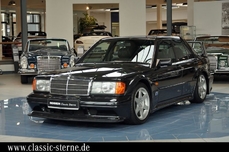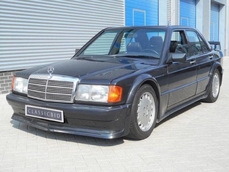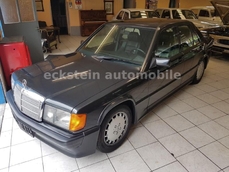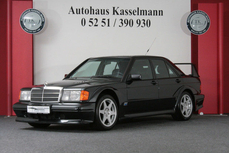Mercedes-Benz 190 2.5-16 E 2.5 16V 1990
General description :
"Baby Benz" mit 204 PSnur etwas mehr als 52.000 KM1 VorbesitzerServicebuch und komplette Dokumentation TypengeschichteDer Mercedes Benz 190 (W201) wurde im Volksmund -aufgrund seiner Größe- liebevoll als "Babybenz" bezeichnet. Über 1,8 Millionen verkaufte Exemplare, belegten den wirtschaftlichen Erfolg. Seit der Markterscheinung 1982 lancierte Mercedes immer wieder neue Motoren-Modelle. Mitte der 80er Jahre startete Mercedes eine Kooperation mit Cosworth für die Entwicklung eines neuen Zylinderkopfes, um auf die gestiegene Nachfrage nach mehr Motorenleistung zu reagieren.Die Krönung ist ohne Zweifel der ab 1987 eingebaute 2.5 Liter 16V. In der Version ohne KAT (RÜF) war er für satte 204 PS verantwortlich. Dieser Motor wurde später auch beim EVOI verwendet und beim legendären EVO II weiterentwickelt auf dann 235 PS. Die gleichzeitig mit KAT erschienen Modelle hatten fast 10PS weniger. History des hier angebotenen Mercedes 190 E 2.5Der hier angebotene 190 E 2.5 16V wurde im November 1989 für den spanischen Markt gebaut. Es handelt sich um die begehrte RÜF Version mit den strammen 204 PS. In Deutschland wurden zu dieser Zeit meist die katalysatoren Motoren verkauft mit 10 PS weniger. Ausgeliefert wurde dieser 190er an Jorge P. in Sevilla in der Farbe „Blauschwarz-Metallic“ (199U) elektrisch verstellbaren Fahrer und Beifahrer Sitz (221+222), Aussentemperaturanzeige (240) Leder perforiert schwarz (271A) elektrisches Stahlschiebedach (412), Kopfstützen im Fond (430) automatische Antenne (532) Diebstahlwarnanlage (551) Klimaanlage (580) elektrische Fensterheber rundum (584+586) wärmedämmendes Glas grün mit Bandfilter und heizbarer Heckscheibe (593) Hecklautsprecher (812) Türkontakte Fondtüren und Leuchte (876). Dieser Babybenz wurde Bestandteil einer ansehnlichen Mercedes Benz Sammlung. Jorge verkaufte diesen Mercedes Benz fast 30 Jahre später an die Scuderia Sportiva Colonia mit durch ein Serviceheft belegten 52.060 KM. Somit ist dieser Mercedes 1. Hand. Der Zustand dieses Fahrzeuges ist einmalig. In jedem Detail verströmt dieser 2.5 16V Jahreswagen Charakter. Der Motor startet nach erstem Verlangen, das 5-Gang Getriebe ist knackig, das Fahrwerk sportlich straff, die Bremsen verzögern hervorragend. Die Karosserie ist ohne Makel, der Lack bis auf die Motorhaube und dem Dach (leider ließ sich aggressiver Vogelkot nicht mehr entfernen) weitgehend original. Die Spaltmaße sind einwandfrei.Zur Zeit besitzt dieses Fahrzeug noch spanische Dokumente. Wir sind gerne bei der Erstellung der Deutschen Papiere, TÜV Abnahme, H-zulassung etc. gegen separate Aufwandsentschädigung behilflich.Natürlich besitzen wir das Serviceheft und komplette Mercedes Bordmappe. Ersatzrad, sowie der komplette Satz Bordwerkzeug und Wagenheber befinden sich ebenfalls an Bord. Zusätzlich haben wir noch einen Satz der originalen Felgen. Ohne Zweifel handelt sich ein sehr authentisches Fahrzeug und in diesem Zustand ein "collectors item".AllgemeinDieses Angebot ist freibleibend und der Zwischenverkauf vorbehalten. Zusatzleistungen wie große 154 Pt. umfassende Inspektion, neuer TÜV, H-Zulassung, Transport, Anmeldung in Deutschland, Wertgutachten etc. sind gegen separate Aufwandsentschädigung möglich.Dieses Fahrzeug steht in unserem Showroom in unserer Manufaktur in Köln-Kalk, Vietor Str. 85, 51103 Köln. Hier finden Sie eine ständige Auswahl von ca. 80 klassischen Automobilen. Wir bitten Sie aber für einen geplanten Besuch um telefonische Voranmeldung.Über unser Serviceangebot und Auswahl von Fahrzeugen informieren Sie sich bitte unter http://www.scuderia-sportiva-colonia.com
Karosserieform : Limousine
Zylinder : 4
Hubraum : 2498 ccm
Leistung : 204 PS
Höchstgeschwindigkeit : 235 km/h
0-100 km/h : 7,2 sec
Leergewicht : 1400 kg
Getriebe : Manuell
Gänge : 5
Antrieb : Heck
Bremse Front : Scheibe
Bremse Heck : Scheibe
Tachostand (abgelesen) : 52.000 km
Erstzulassung : n/a
Anzahl Vorbesitzer : 1
Matching numbers : Ja
SSC-Nummer : 425
Außenfarbe : Schwarz
Innenfarbe : Schwarz
Herstellerfarbbezeichnung (außen) : Blauschwarz Metallic
Innenmaterial : Leder
Schiebedach : Ja
Elektrische Fensterheber : Ja
Faltdach : Nein
Klimaanlage : Ja
Servolenkung : Ja
Mwst. ausweisbar : Nein
https://scuderia-sportiva-colonia.de/de/fahrzeuge/496-mercedes-benz-190-e-2-5-16v
1990 Mercedes-Benz 190 2.5-16 E 2.5 16V is listed sold on ClassicDigest in Köln by Auto Dealer for €52500.
Car Facts
Car type : Car Make : Mercedes-Benz Model : 190 2.5-16 Model Version : E 2.5 16V Engine size : 2.5 Model Year : 1990 Sub type : Sedan Location : Vietor Str. 85 51103 Köln, Germany
Sold
Seller Information
Sold
People who viewed this Mercedes-Benz 190 2.5-16 also viewed similar Mercedes-Benz listed at ClassicDigest
Other cars listed for sale by this dealer
About Mercedes-Benz
In the annals of automotive history, the journey of Mercedes-Benz is a tale that unfolds with the ingenuity of its founding pioneers. In the year 1886, Karl Benz crafted the Benz Patent Motorwagen, a creation that would go down in history as the world's inaugural automobile. Unbeknownst to him, this moment marked the genesis of what would evolve into the most illustrious premium car manufacturer globally. The financial underpinning of this pioneering venture, interestingly, was provided by Karl Benz's wife, Bertha Benz, demonstrating a remarkable partnership that would set the tone for Mercedes-Benz's legacy.A parallel narrative emerged not far away, as Daimler-Motoren-Gesellschaft, founded by Gottlieb Daimler and Wilhelm Maybach, entered the scene. In 1901, they unveiled their automobile under the now-famous moniker "Mercedes," meaning "godsend" in Spanish. This name was bestowed upon the car at the behest of Emil Jellinek's daughter, the distributor for Daimler-Motoren-Gesellschaft. The wheels of innovation were set in motion.
Fast forward to 1926, a pivotal year that witnessed the merger of Daimler with Benz & Cie., culminating in the birth of Daimler-Benz. The amalgamation saw the adoption of "Mercedes-Benz" as the distinguished trademark for their automobiles, fusing the legacies of two visionary entities into one.
Contrary to perceptions of conservatism, the trajectory of Daimler-Benz unfolds as a chronicle of industry firsts. From the introduction of the honeycomb radiator to the float carburetor, and the pioneering implementation of four-wheel brakes in 1924, Daimler-Benz consistently pushed the boundaries of automotive innovation. The diesel-powered Mercedes-Benz 260 D in 1936 marked the inception of diesel engines in passenger cars. The iconic Mercedes-Benz 300SL Gullwing made history as the first car with direct fuel injection, albeit the Gutbrod's tiny 2-stroke engine can claim precedence.
Safety innovations became a hallmark, with Béla Barényi's patented safety cell design in the "Ponton"-models in 1951, featuring front and rear crumple zones. The W116 450SEL 6.9 saw the introduction of the Anti-Lock Brake system (ABS), another pioneering safety feature. From the first production airbags and beyond, the legacy of "firsts" continued to be etched into the fabric of Daimler-Benz.
Over its centennial journey, Mercedes-Benz has not merely produced cars but has sculpted automotive icons. The SSKL, 710 SSK Trossi Roadster, 770K Grosser, 540K Spezial Roadster, 300SL Gullwing, w100 600 Pullman, w111 280SE 3.5 Flachkühler, w113 230SL Pagoda, w109 300 SEL 6.3, and w201 2.3-16 Cosworth stand testament to the brand's commitment to engineering excellence.
The roaring Silver Arrows, or "Silberpfeile," including the W 25, W 125, W154, W165, and W196, created a legacy of dominance on the racetrack. These machines were not merely cars; they were expressions of precision, speed, and an indomitable spirit that left their competitors in the dust.
As Mercedes-Benz marches into the future, it does so not just as an automaker but as a custodian of a legacy, a torchbearer of innovation, and a beacon of automotive excellence. The road ahead is sure to witness the continued fusion of cutting-edge technology, timeless design, and an unwavering commitment to setting new standards in the world of automobiles.
One luminary figure who left an indelible mark was Béla Barényi, often heralded as the "father of passive safety" for his pioneering work in safety engineering. His patented safety cell design, featuring front and rear crumple zones, became a hallmark of Mercedes-Benz's commitment to occupant safety, setting new standards that reverberated throughout the automotive world.
Moving through the chronicles, the collaborative genius of Wilhelm Maybach, alongside Gottlieb Daimler, laid the foundation for Daimler-Motoren-Gesellschaft. Their innovations not only birthed the first Mercedes but established a culture of relentless pursuit of technological excellence that remains integral to Mercedes-Benz's DNA.
In the post-merger era of 1926, Ferdinand Porsche emerged as a prominent figure within Mercedes-Benz. His work on the Mercedes-Benz S-Type, a supercharged race car, garnered acclaim and set the stage for a legacy that extended far beyond the marque. Porsche's impact would later extend to his eponymous company, but his influence at Mercedes-Benz during those formative years was pivotal.
As the 20th century progressed, the legendary Rudolf Uhlenhaut emerged as a key figure. Uhlenhaut, an accomplished engineer and the driving force behind the iconic Silver Arrows, played a crucial role in Mercedes-Benz's dominance in motorsports. His engineering prowess and attention to detail were instrumental in creating some of the most formidable racing cars of the era.
In the latter half of the century, figures like Bruno Sacco, the head of design at Mercedes-Benz from 1975 to 1999, left an indelible imprint on the brand's aesthetic identity. Sacco's design philosophy, characterized by clean lines and timeless elegance, shaped iconic models like the W126 S-Class and the W201 190E, solidifying Mercedes-Benz's reputation for luxury and sophistication.
The narrative would be incomplete without acknowledging the contributions of engineers like Hans Scherenberg, whose leadership in the 1970s ushered in a new era of technological innovation at Mercedes-Benz. Scherenberg's tenure saw the development of groundbreaking technologies, including the Anti-Lock Brake system (ABS) and the introduction of airbags in production cars.


















